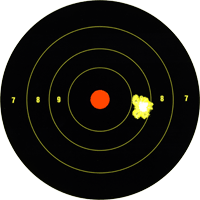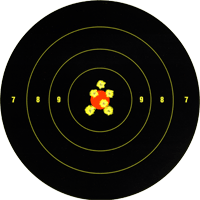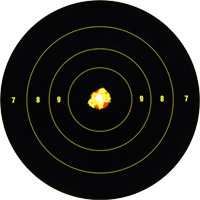Accuracy and Precision are key to long-distance shooting.
Peterson Cartridge is committed to ensuring the most accurate and precise brass and ammunition available to consumers today, but what exactly is the difference between the two?
 |
PrecisionThe target to the left is a good visual for precision. The definition of precision, according to the Merriam-Webster dictionary, is “the degree of refinement with which an operation is performed or a measurement stated”. The goal in long-distance shooting is to have one “ragged hole” in the center of the target when you are finished. The target to the left has one “ragged hole”, however, if the shooter was aiming for the center of the target, they lack accuracy. Precision without accuracy means the shooter will miss their intended target by the same distance repeatedly. |
 |
AccuracyThis next target is a good visual for accuracy. The definition of accuracy, according to the Merriam-Webster dictionary, is “freedom from mistake or error”. As you can see with the target to the left, the shooter was much closer to the center of the target with their shots. However, if the shooter was aiming for the center of the target, they were unable to hit exactly their mark with each shot. Accuracy without precision results in the shooter being unable to hit exactly their intended mark with every shot. |
 |
Accuracy and PrecisionThe last target shows what happens when a shooter is both precise and accurate. Not only did all of the projectiles land in the same “ragged hole”, the “ragged hole” is directly over the point of aim. Championships are won when accuracy meets precision. Below we will explain the link between consistent rifle casings and producing one “ragged hole” over your point of aim. |
Why does the casing matter?
For the vast majority of all ammunition fired in the commercial market, extreme accuracy is not necessary. What we mean by that is, most of the rounds fired by average citizens are aimed at targets 100 meters or less away from the shooter. When the distance you're shooting isn't very far, or you have a large target to hit, average ammunition built with average components will do the job.
For example, if the ammunition you've purchased is going to be used while hunting White-tailed deer, your requirements for the ammunition will be different than if you are trying to hit a target at or beyond 500 meters away. If the goal is to shoot a target the size of a deer somewhere near 100 meters or less, purchasing ammunition from your local gun shop, produced by any one of the four large ammunition producers, will likely be just fine.
When you are shooting long distances, over 500 meters, the smallest “inconsistencies” between each loaded round can make the difference between hitting your intended target and missing by a meter or more. When we mention small “inconsistencies” in each round, we aren’t talking about using the wrong powder or primer. We are talking about 1 or 2 extra grains of the correct powder. We are talking about the projectile weighing more than a grain different from the last projectile. We are talking about the casing having a slight variation in internal volume, or the casing’s neck being a little thicker on one side. We are talking about the casing having a non-uniform flash hole. All of these “inconsistencies” can make a difference when this shot is expected to perform exactly the same as the last shot at great distances.
Our casings are crafted for people who want the satisfaction of loading their own ammunition. The type of people who sit at a bench in their basement after dinner each night measuring and weighing components to find small variations. The type of people who weigh out each charge of propellant to ensure consistent velocities in the ammunition they load. We aren't for the majority of shooters, but we are for the demanding.
In our industry, consistency is the name of the game. Specifically, how close can we make the next casing to the last casing. That is why we purchased the most advanced case manufacturing equipment currently available. Some folks in the industry called us crazy when they found out we purchased new equipment. They said it runs too slow. They criticized us for not purchasing case manufacturing equipment designed in the 1940s. They said the old equipment runs so much faster than the new equipment.
We agree the old machinery runs faster. We agree everybody in the industry uses the old equipment. We also know that to achieve match quality components, our competitors have to hand weigh and measure each component. They don't do this because they want to, they do this because they have to. Their machinery is not capable of producing exactly identical casings like ours is.
Component to component uniformity is what produces precision. Having the internal volume of each casing be the same will help ensure uniform pressures inside the finished round when it is fired. Having the correct hardness in the casing mouth and neck will help ensure uniform bullet seating and release. Having limited casing sidewall variations will help prevent the case from cracking when fired, and also ensures neck concentricity. Having the correct hardness levels in our case heads will allow you more reloads per case. In one word, consistency. Our ability to consistently produce casing after casing which are identical to each other is what allows our casings to produce precise and accurate shot performance.